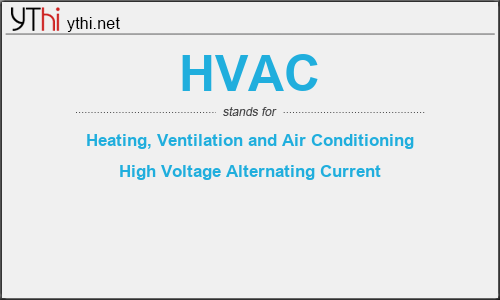What does HVAC mean? What is the full form of HVAC?
1, The full form of HVAC is Heating, Ventilation and Air Conditioning. It’s used on Technology ,General in Worldwide
Heating, ventilation, and air conditioning (HVAC) are the technology of indoor and vehicular environmental comfort. Its goal is to provide thermal comfort and acceptable indoor air quality. HVAC system design is a subdiscipline of mechanical engineering, based on thermodynamics, fluid mechanics, and heat transfer principles. “Refrigeration” is sometimes added to the field’s abbreviation, as HVAC&R or HVACR or “ventilation” is dropped, as in HACR (as in the designation of HACR-rated circuit breakers).
HVAC is an important part of residential structures such as single-family homes, apartment buildings, hotels, and senior living facilities, medium to large industrial and office buildings such as skyscrapers and hospitals, vehicles such as cars, trains, airplanes, ships and submarines, and in marine environments, where safe and healthy building conditions are regulated with respect to temperature and humidity, using fresh air from outdoors.
Ventilating or ventilation (the “V” in HVAC) is the process of exchanging or replacing air in any space to provide high indoor air quality which involves temperature control, oxygen replenishment, and removal of moisture, odors, smoke, heat, dust, airborne bacteria, carbon dioxide, and other gases. Ventilation removes unpleasant smells and excessive moisture, introduces outside air, keeps interior building air circulating, and prevents stagnation of the interior air.
Ventilation often refers to the intentional delivery of the outside air to the building’s indoor environment. It is one of the most important factors for maintaining acceptable indoor air quality in buildings. Methods for ventilating a building are divided into mechanical/forced and natural types.
2, The full form of HVAC is High Voltage Alternating Current. It’s used on Academic & Science ,Electrical in Worldwide
High Voltage Alternating Current (HVAC) is widely used in transmission and distribution systems to reduce electrical losses.
Having satisfied the rising demand in transmission projects with proven technology in HV cables for some time, Borealis and Borouge have an impressive track record. More than 300,000 kilometers of cabling has been installed worldwide using Borealis compounds, a distance that spans over three times the circumference of the earth, and we are on our way to making another global lap with Borlink™ XLPE based on Supercure technology.
High-voltage direct current (HVDC) technology offers several advantages compared to alternating current transmission systems. For example, it allows more efficient bulk power transfer over long distances. However, the cost is an important variable in the equation. Once installed, HVDC transmission systems are an integral part of the electrical power system, improving stability, reliability, and transmission capacity.
Typical utility-scale power plants generate alternating current (AC) electricity, and most electrical loads run on AC power. Thus, the majority of transmission lines carrying power around the world are of the AC type. However, there are instances when high-voltage direct current (HVDC) transmission systems offer significant benefits.
“One big advantage to HVDC is the efficiency of power transmission over long distances,” George Culbertson, vice president of power delivery markets for HDR, told POWER. “If the transmission line route is longer than about 300 miles, DC is a better option because AC lines have more line losses than DC for bulk power transfer.”
HVAC
means
Heating, Ventilation and Air Conditioning![]()
Translate Heating, Ventilation and Air Conditioning to other language.
High Voltage Alternating Current![]()
Translate High Voltage Alternating Current to other language.


Leave a Reply
You must be logged in to post a comment.